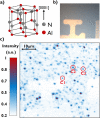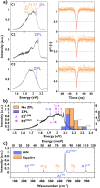Room-Temperature Quantum Emitter in Aluminum Nitride
- PMID: 32905301
- PMCID: PMC7469133
- DOI: 10.1021/acsphotonics.0c00528
Room-Temperature Quantum Emitter in Aluminum Nitride
Abstract
A device that is able to produce single photons is a fundamental building block for a number of quantum technologies. Significant progress has been made in engineering quantum emission in the solid state, for instance, using semiconductor quantum dots as well as defect sites in bulk and two-dimensional materials. Here we report the discovery of a room-temperature quantum emitter embedded deep within the band gap of aluminum nitride. Using spectral, polarization, and photon-counting time-resolved measurements we demonstrate bright (>105 counts s-1), pure (g (2)(0) < 0.2), and polarized room-temperature quantum light emission from color centers in this commercially important semiconductor.
Copyright © 2020 American Chemical Society.
Conflict of interest statement
The authors declare no competing financial interest.
Figures




References
-
- Nguyen M.; Zhu T.; Kianinia M.; Massabuau F.; Aharonovich I.; Toth M.; Oliver R.; Bradac C. Effects of microstructure and growth conditions on quantum emitters in gallium nitride. APL Mater. 2019, 7, 081106.10.1063/1.5098794. - DOI
LinkOut - more resources
Full Text Sources
Other Literature Sources
Miscellaneous
